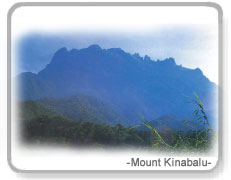
[ Back ] [ Next ][ Introduction ] [ History of Malaysia ] [ The Land ] [ The People ] [ Transportation and Communications ] [ Way of Life ] [ Acknowledgement ]
is
unique in that it is the only country that has territory on
 both
the mainland and insular regions of Southeast Asia. Peninsular Malaysia is
largely mountainous (one-half of the total area is more than 500 ft [150 m]
above sea level) and consists of several north-south-aligned mountain ranges
dominated by the 300mi- (500km-) long Main Range, with elevations rising to more
than 7000 ft (2000 m). Bordering the mountainous core are coastal lowlands that
are heavily populated on the west and are narrow, swampy, and densely forested
on the east. In East Malaysia the coastal plains (10 to 20 mi [16 to 32 km] wide
in the east and 20 to 40 mile [32 to 64 km] wide in the west) rise to a hill and
valley region and then to a mountainous core that has elevations between 4000
and 7000 ft (1200 and 2000 m) and includes
(13455
ft [4101 m]) in the extreme northeast, the highest point in the country. The
270mi- (435km-) long
is
the principal river of Peninsular Malaysia.
both
the mainland and insular regions of Southeast Asia. Peninsular Malaysia is
largely mountainous (one-half of the total area is more than 500 ft [150 m]
above sea level) and consists of several north-south-aligned mountain ranges
dominated by the 300mi- (500km-) long Main Range, with elevations rising to more
than 7000 ft (2000 m). Bordering the mountainous core are coastal lowlands that
are heavily populated on the west and are narrow, swampy, and densely forested
on the east. In East Malaysia the coastal plains (10 to 20 mi [16 to 32 km] wide
in the east and 20 to 40 mile [32 to 64 km] wide in the west) rise to a hill and
valley region and then to a mountainous core that has elevations between 4000
and 7000 ft (1200 and 2000 m) and includes
(13455
ft [4101 m]) in the extreme northeast, the highest point in the country. The
270mi- (435km-) long
is
the principal river of Peninsular Malaysia.
and
the
are
the principal rivers of Sarawak and Sabah, respectively. Malaysia's equatorial
climate is strongly influenced by northeast November or December to March) and
southwest (June to September or early October) monsoons. Mean annual
temperatures range between 77 - 86 F (25 - 30 C) in the lowlands and 72 - 83 F
(22 - 28 C) on the interior mountains. The mean annual rainfall is very high
and ranges from 100 inches (2,500 mm) in Peninsular Malaysia to 90 inches
(2,300 mm) in Sarawak and to 130 inches (3,300 mm) in Sabah. Relative humidity
is also high, averaging 80 to 85 percent.The hot and humid climate favors
dense tropical vegetation - up to three-fifths of the land is under forests,
most of it evergreen rain forests, and vegetation includes
.
The country's varied animal life includes
East
Malaysia has one of the largest and most varied bird populations in the world,
including hornbills, parrots, broadbills, swifts, pigeons, woodpeckers, and
many other species. Tree crops, notably rubber and palm oil, are the country's
most important cash crops. Malaysia's tin reserves are the third largest in
the world after those of Brazil and China. Its proven reserves of petroleum
and natural gas are also important.


 both
the mainland and insular regions of Southeast Asia. Peninsular Malaysia is
largely mountainous (one-half of the total area is more than 500 ft [150 m]
above sea level) and consists of several north-south-aligned mountain ranges
dominated by the 300mi- (500km-) long Main Range, with elevations rising to more
than 7000 ft (2000 m). Bordering the mountainous core are coastal lowlands that
are heavily populated on the west and are narrow, swampy, and densely forested
on the east. In East Malaysia the coastal plains (10 to 20 mi [16 to 32 km] wide
in the east and 20 to 40 mile [32 to 64 km] wide in the west) rise to a hill and
valley region and then to a mountainous core that has elevations between 4000
and 7000 ft (1200 and 2000 m) and includes
(13455
ft [4101 m]) in the extreme northeast, the highest point in the country. The
270mi- (435km-) long
is
the principal river of Peninsular Malaysia.
both
the mainland and insular regions of Southeast Asia. Peninsular Malaysia is
largely mountainous (one-half of the total area is more than 500 ft [150 m]
above sea level) and consists of several north-south-aligned mountain ranges
dominated by the 300mi- (500km-) long Main Range, with elevations rising to more
than 7000 ft (2000 m). Bordering the mountainous core are coastal lowlands that
are heavily populated on the west and are narrow, swampy, and densely forested
on the east. In East Malaysia the coastal plains (10 to 20 mi [16 to 32 km] wide
in the east and 20 to 40 mile [32 to 64 km] wide in the west) rise to a hill and
valley region and then to a mountainous core that has elevations between 4000
and 7000 ft (1200 and 2000 m) and includes
(13455
ft [4101 m]) in the extreme northeast, the highest point in the country. The
270mi- (435km-) long
is
the principal river of Peninsular Malaysia.